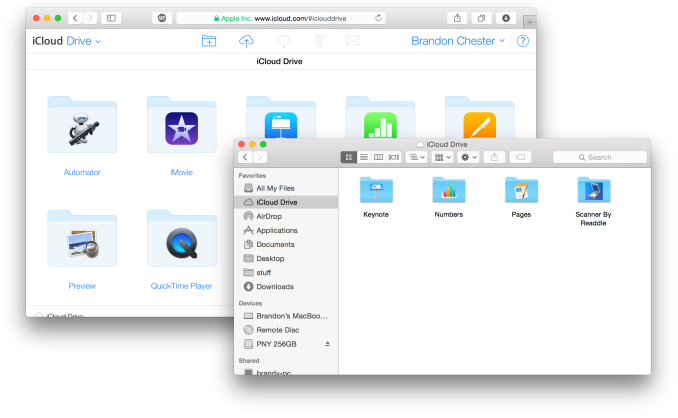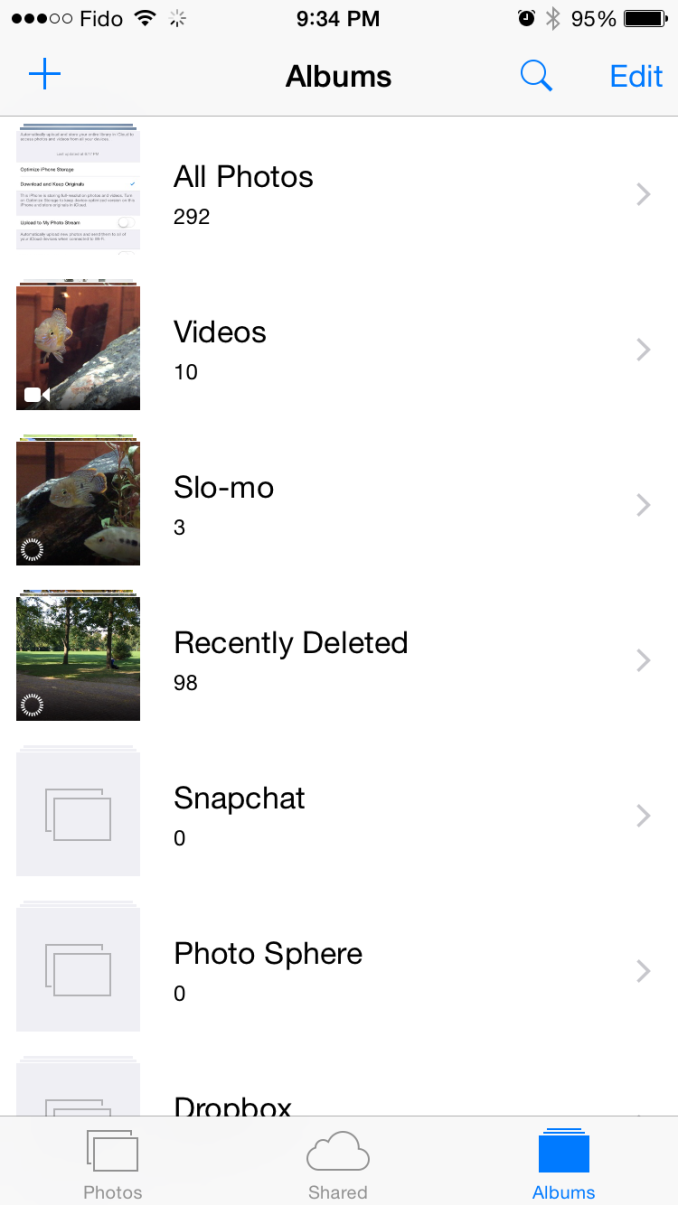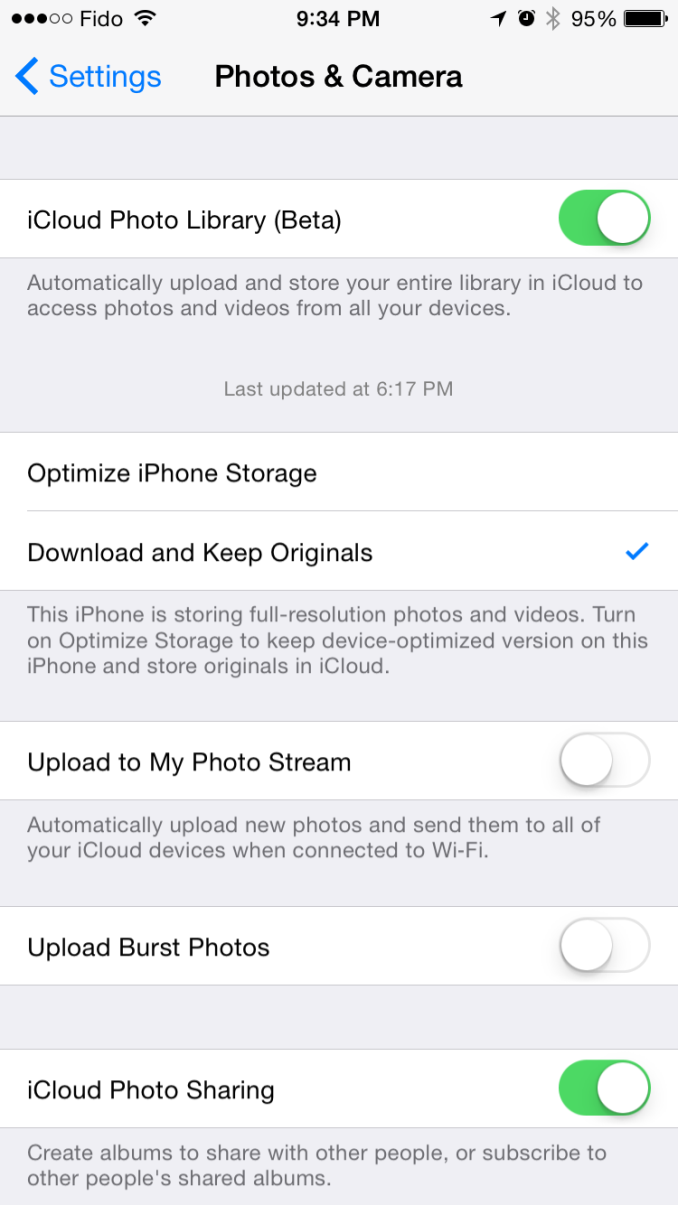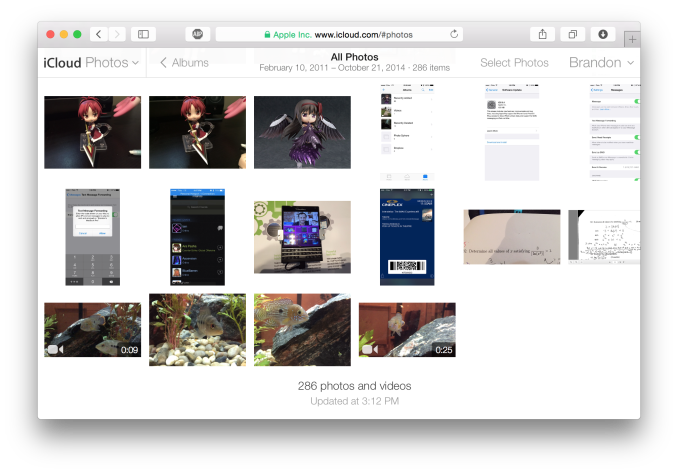A Look At OS X Yosemite And iOS 8.1
by Brandon Chester on October 27, 2014 8:00 AM ESTiCloud Drive and Photo Library
At WWDC 2014 Apple introduced a number of significant additions and improvements to their iCloud service for developers and consumers. On the user side we got iCloud Drive and iCloud Photos. Both of these features position themselves against the offerings from other companies in the increasingly competitive cloud storage space. Apple's advantage within their own ecosystem is how iCloud integrates with their own systems better than Dropbox, OneDrive, or Google Drive ever can. Integration cannot keep a service alive if it becomes stagnant though, and these two features are very necessary additions.
iCloud Drive
iCloud Drive is arguably the more important and interesting of the two features. In the past, iCloud has been something like a magic black box that users can never access or even look into. Files would be created in an application, sent to iCloud, and hopefully they would show up on your other devices. This type of model makes for a great document synchronizing solution, but it's not very good at some of the other things people have grown to expect from a cloud storage service. Apple had to build something that allowed users to manage their documents stored in iCloud, including the ability to add or remove files as needed without having to go into each individual iCloud enabled application.
As a file storage service, iCloud Drive functions exactly how you would expect. You can make folders, and upload files to those folders which can be accessed on any other device with access to iCloud drive. In addition to those files, iCloud Drive also houses the files for any iCloud enabled application. As you can see above, each iWork and iLife application also has its files accessible in iCloud Drive, along with third party iCloud enabled apps like Scanner by Readdle.
Your drive can be accessed in a few different ways. In OS X it's integrated right into Finder and is listed in Favorites by default. Windows users can download Apple's iCloud Control Panel to have it accessible via Windows Explorer. I've avoided the Windows solution because my past experience is that having iCloud Control Panel do anything with to Windows Explorer will make it crash Windows Explorer. While I haven't experienced that while using the new Control Panel 4.0 for the purposes of this review, I still don't trust it.
The third method is to access it from iCloud.com. You would think that with these 3 options, including a web based option, Apple would have every platform covered. Unfortunately they don't. There is no way to directly manage iCloud Drive from an iOS device because iCloud.com displays a special page with links to get information on setting up iCloud and installing Find my iPhone. Applications that integrate with iCloud have the ability to open documents stored in iCloud Drive using the document picker, but there's no way to move or delete other files. I don't know if this is just an oversight or if Apple doesn't want it accessible via mobile but it is honestly a necessary feature and I hope to see it added soon either through an app or through iCloud.com on iOS.
iCloud Photos
iCloud Photo Library was released with iOS 8.1 in the form of a public beta. I actually wrote about it in my initial iOS 8 review due to confusion regarding its availability. It was only near the end of Apple's beta cycle that they revealed SMS Forwarding and iCloud Photo Library would be arriving with a later release. On top of that, using the OS X Yosemite preview would cause the option to reveal itself on your iOS devices. As a result, my devices running the gold master build still had the feature and I was unaware that for most users it would not be accessible until October. But now October has come and we can take a closer look at iCloud Photo Library in its beta form. Users who want to try it out just need to opt into the beta in the Photos & Camera section of the Settings application. Doing so will change the name of Camera Roll to All Photos in the Photos app.
As I've stated before, iCloud Photo Library is not the same as Photo Stream. Photo Stream is really just a method of pushing your photos between all your devices. It relies entirely on local storage and the photos are removed from iCloud after 30 days. iCloud Photo Library keeps all of your pictures in the cloud, and keeps the most recent and frequently accessed ones locally on your device. This is often referred to as nearline storage. Users can also specify to download copies that are optimized for their display resolution which will save space compared to storing full resolution copies on local storage.
iCloud Photo Library is definitely a great feature, but right now the experience is missing a few key things. On iOS it works very well due to how the entire photo experience is within the Photos application. On OS X it's still lacking. Some people may feel it's unfair to criticize certain aspects due to the fact that the feature is technically a beta, but oversights need to be addressed for them to be fixed.
The biggest issue for me is that Apple's Photos application for OS X won't be shipping until early 2015. That's quite a long time after the initial release of Yosemite, and an even longer time after iOS 8 was released. This means that there is currently no way to access photos stored in iCloud on a Mac unless it is done through the web interface. It's an okay solution for now, but the web interface is nothing spectacular. It's essentially the iPad Photos app interface but in a web browser. My biggest issue with it is that it doesn't actually scale. The Safari window with iCloud Photos above is as small as you can make the window without introducing horizontal scrolling. Making the window larger doesn't show more photos on the screen, it just makes the thumbnails bigger. This contrasts with iCloud Drive's web interface which does scale the arrangement of folders based on the size and shape of the window.
There is definitely a lot of pressure involved in trying to ship two major operating system updates around the same time every year, and to pack in new features that work across both of them. Apple made it clear at WWDC 2014 that Photos on OS X wasn't going to be ready until 2015, but I think the issue created by that could have been addressed much better by updating iPhoto to support iCloud Photo Library rather than relying on the web interface.














173 Comments
View All Comments
DPUser - Wednesday, October 29, 2014 - link
I'm not gonna buy an iMac, but who wants a touchscreen on their desktop? I, for one, do not like fingerprints on my monitors. Or beer for that matter.annah_souls - Saturday, November 1, 2014 - link
$2500 is very cheap. I can buy as many as I want. Soorrry for you, poor guy.I don't understand why you are so upset with Apple. If you think it didn't worth your money, don't buy it. I don't see anyone threaten you to but Apple product. Post your comment like grown up people please.
shahrooz - Wednesday, October 29, 2014 - link
I think people who buy apple products don't really care where their money is going, because all of their products are overpriced. they are not bad at all, but they are never as good as their price suggest.Wolfpup - Wednesday, October 29, 2014 - link
<<<Users who are familiar with computers no longer need a distinct outline and heavy shading to recognize that a button is something they click or tap.>>>This is just plain false. It's not that we don't understand that something doesn't have to physically look like a button to be clickable-the outline or shading or 3D look or whatever is so that it's easily readable AS an interface element.
Mostly the "flat" look is just a stylistic thing, but it does have some drawbacks in areas where it's no longer immediately clear if you can interact with something.
Mostly in both iOS 7 and Windows 8 I don't find it to be a big deal, but an example where it's clearly inferior is the "show desktop" button on Windows 8. In 7, it's not offensive, it just looks raised and is clearly an interface element. In 8, it's still there, but there's no visual way to know that it's there. 8's lack of a start button is another great example. There was no way to know that was clickable and would bring up the start screen unless you already know that it's clickable and brings up the start screen. 8.1 thankfully fixes that, and I think it's an improvement regardless of whether you know what it does.
<<<They don't want their Calendar and Reminders applications to have leather borders, stitching, and paper like their calendar and date book in the real world, because doing so confines them to the limitations of those physical objects. >>>
Neither part of that is true either. The first part is a stylistic choice, and frankly I think it's a fun one. Knowing that a notepad doesn't have to look like a notepad doesn't mean that you won't prefer a fun visual design that looks like one over a plain flat white area to type in (or whatever). that's just personal preference. And making it look like something physical doesn't really restrict any function either. These programs can do all sorts of things physical objects can't, and that's true whether they have a fun real world texture or not.
At any rate I'm 100% in the camp that buttons should look like buttons. Whether flat looking, or 3D looking (once our designer overlords come back around and claim flat is so yesterday and 3D is the big hot new thing again), either way artistic design should NEVER get in the way of usability design. You should be able to at least tell what things you can interact with even if you've never used a program or OS before.
jdshewman - Friday, October 31, 2014 - link
Reading some of these comments are comical and mostly bias. First, the complaint about cost between Mac vs Windows laptops are hysterical. The parts utilized in the Mac are all top notch parts. They are not poorly fabricated nor statistically vulnerable to technical aspects. How many windows laptops have solid state drives, let alone at a reasonable price? I mean, windows runs faster loaded on a mac than a PC manufacturer at the same price point. Second, able to upgrade. Seriously, what would a person need with more than 16gb of ram or a higher CPU (higher than an i5) unless you are cracking the genetic code. These are mindless arguments to the uniformed. Buy a Mac laptop today it will run flawless with any apps for many years. Buy a windows laptop and pray it last more than a couple years with their outdated parts.Impulses - Friday, October 31, 2014 - link
"How many windows laptops have solid state drives, let alone at a reasonable price?"Umm, there's plenty, and you can usually get a larger drive for the same price. Apple has charged a larger than usual premium for drive/RAM upgrades since time immemorium. What does "statistically vulnerable to technical aspects" even mean?
There are things that can justify an Apple price premium (Apple Care, resale value, preference for OS X, display quality)... Somehow you fail to mention even one relevant reason, bravo.
P.S. Every content creator under the sun would smack you for asking who needs more RAM or a faster CPU, for video and photo editing both those things often pay for themselves in no time flat within a professional environment.
V900 - Saturday, November 1, 2014 - link
"Umm, there's plenty"What nonsense. Sure, you can get a Windows laptop with some of the same features as a Macbook. It'll sometimes be cheaper too, just like you can find a Hyundai with a V6 engine for less than you'd pay for a BMW with a V6.
But the two can't compare in neither quality, experience nor resale value, just like the cheap Windows laptop can't compare with a Macbook.
(And usually will cost more in the end. Its nice to save a couple of hundred dollars. But a two year old Macbook will easily sell for 50% of what you paid for it, whereas the "inexpensive" Windows laptop will typically be close to worthless, and will cost you more in the end.)
Sorry buddy, if you want a quality laptop, you can find one running Windows. They're just pretty rare, and cost as much or more than an Apple product.
V900 - Saturday, November 1, 2014 - link
BTW: Your comment about content creators doesn't make any sense.The Macbook and Mac Mini both max out at 16GB RAM. Since time is money for these people, why would they try to save, what amounts to a couple hours overtime pay for them, on installing 3rd party RAM themselves?!?
If they'll really need it eventually, they might as well splurge on the 16GB machine from the get go. Hence they don't really need expandable RAM.
As for regular consumers, they strictly speaking don't really need it anymore either. Upgradable RAM had a purpose when 1gb or 2gb ram was the standard, but not today. A 4gb Macbook will still be plenty fast 5 or 6 years from now. This isn't Windows machines we're talking about, that seem to degrade exponentially for every year.
Which you'd know if you'd ever tried a Macbook. A 4 year old Mac with 2gb ram is fine for everyday use even today.
Impulses - Saturday, November 1, 2014 - link
Not sure why you're so gung ho about replying to my comment, specially when you don't even seem to have read it. I was only refuting that there aren't plenty of Windows laptops with SSD, which the comment I replied to stated.I quoted many of the same reasons you did why a MBP can justify it's price premium (MBA has a tougher case IMO), or did you miss that?
Regarding RAM, the argument wasn't about third party upgrades, but about the fact that "maxing out" at 16GB ISN'T enough for content creators. That would be the bare minimum for many, some would prefer 32GB+ and it has nothing to do with the OS.
V900 - Saturday, November 1, 2014 - link
It's a lot of useful features for sure, but personally I'll wait with upgrading.I really dislike the new design, but hopefully there'll be some third party software options to bring back the Mavericks look. If not, I guess I'll have to wait for 10.11, and the inevitable paring down of the flatness...